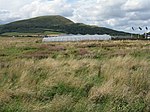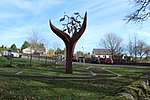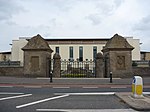Castle Law
Archaeological sites in MidlothianHill forts in ScotlandHills of the Scottish Midland ValleyHistoric Environment Scotland propertiesLothians geography stubs ... and 2 more
Mountains and hills of MidlothianScheduled Ancient Monuments in Midlothian

Castle Law is a hill south west of Fairmilehead in the Pentland Hills in Midlothian, Scotland. It is best known for the Iron Age hill fort on its slopes.
Excerpt from the Wikipedia article Castle Law (License: CC BY-SA 3.0, Authors, Images).Castle Law
Glencorse View Walk,
Geographical coordinates (GPS) Address Nearby Places Show on map
Geographical coordinates (GPS)
| Latitude | Longitude |
|---|---|
| N 55.861838888889 ° | E -3.2334361111111 ° |
Address
Castlelaw Fort
Glencorse View Walk
EH26 0PR
Scotland, United Kingdom
Open on Google Maps







